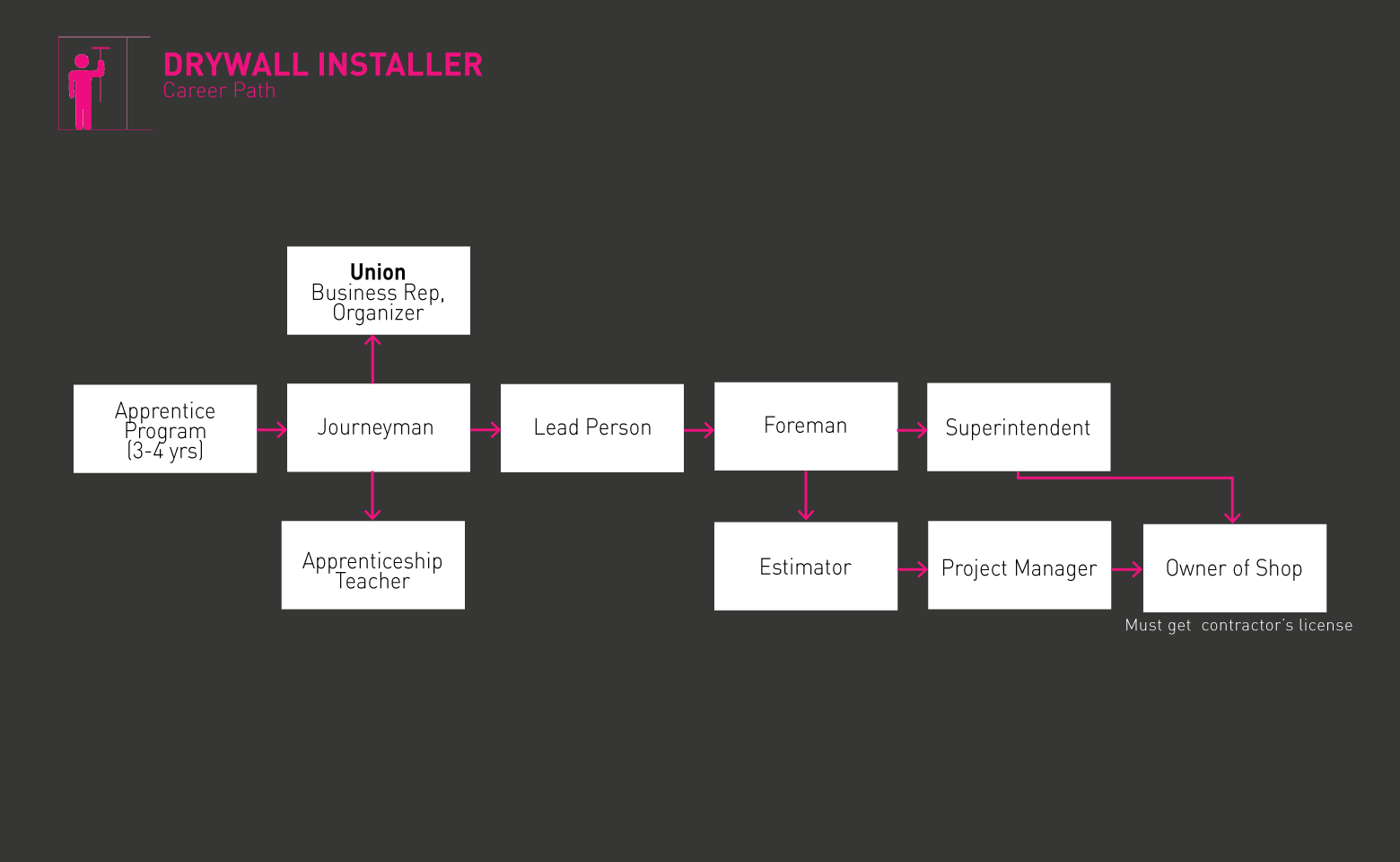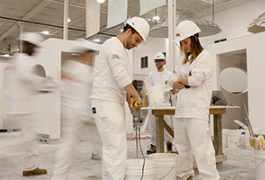Focos de atención
Drywall Finisher, Drywall Hanger, Drywall Mechanic, Ceiling Installer, Dry Wall Installer, Exterior Interior Specialist, Acoustical Installer, Metal Framer, Metal Stud Framer
Los instaladores de paneles de yeso y azulejos cuelgan paneles en las paredes y techos de los edificios. Los tapers (finalizadores) preparan los paneles de pared para pintarlos, utilizando cinta adhesiva y otros materiales.
- Una sensación de logro cuando se termina un proyecto
- Autonomía: Puedes trabajar tanto o tan poco como quieras. Basado en proyectos.
- Normalmente se empieza de 6:30 a 15:30: Capaz de hacer otros proyectos por la tarde.
- Trabajar con las manos!: "Si tienes inclinación por la mecánica, los oficios son excelentes para ello".
“I took my kids to the California Academy of Sciences. I ran that project when it was first built. They love going there and being able to tell people that “my daddy painted this.” To see the pride and joy in their eyes…that they were almost a part of it. It’s about having the pride in the workmanship of being a craftsman.” Robert Williams III, Painter, Business Representative, District Council 16
Los instaladores de paneles de yeso suelen hacer lo siguiente:
- Revisa los planos de diseño para minimizar el número de cortes y el desperdicio de tableros.
- Mide la ubicación de las tomas de corriente, la fontanería, las ventanas y los respiraderos.
- Corta paneles de yeso a la medida correcta, utilizando cuchillas de uso general y sierras eléctricas.
- Fija los paneles de yeso a los montantes de la pared interior, utilizando clavos o tornillos.
- Recorte con arena los bordes ásperos para que las tablas se unan uniformemente.
Los instaladores de techos suelen hacer lo siguiente:
- Mide según los planos o dibujos.
- Soportes con clavos o tornillos.
- Coloca baldosas o láminas de materiales amortiguadores en los techos.
- Mantiene la baldosa en su sitio con cemento cola, clavos o tornillos.
- A veces se les llama carpinteros acústicos porque trabajan con baldosas que bloquean el sonido.
Los tapers suelen hacer lo siguiente:
- Prepara la superficie de la pared (tablero) parcheando los agujeros de los clavos.
- Aplica cinta adhesiva y utiliza compuesto de sellado para cubrir las juntas entre los tableros de pared.
- Aplica capas adicionales de compuesto de sellado para crear una superficie uniforme.
- Lija todas las juntas y agujeros hasta conseguir un acabado liso y sin fisuras.
Los instaladores también se llaman enmarcadores o colgadores. Los tapers también se llaman finishers.
- Destreza manual: buen manejo de las manos
- Coordinación mano-ojo
- Pensamiento crítico y resolución de problemas: Te encontrarás con problemas inesperados y tendrás que resolverlos a tiempo.
- Atención al detalle
- Fuerza y resistencia física
- Trabaja en el interior.
- Bastante exigente desde el punto de vista físico: los trabajadores pasan la mayor parte del día de pie, agachados o estirados, y a menudo deben levantar y maniobrar tableros de pared pesados y de gran tamaño.
- Para trabajar en los techos, puede que tenga que subirse a zancos, escaleras o andamios.
- Debe llevar máscaras, gafas y guantes de protección.
- Empresa de contratistas de tabiquería en seco: Van desde la tienda de mamá y papá (4-8) a las grandes tiendas (200+)
- Mantenimiento de instalaciones y edificios
- El sindicato negocia tarifas competitivas: Por ejemplo) En el área de la bahía de San Francisco, 40,37 dólares por hora como journeyman, que es el puesto que se ocupa después de ser aprendiz.
- Prestaciones médicas completas (médico, dental, oftalmológico)
- Pensión
- Anualidad
- Acceso a mejores puestos de trabajo y oportunidades increíbles.
"He trabajado en el puente Golden Gate, en la parte superior de la torre del nuevo puente de la bahía y en todos los aspectos de la Academia de Ciencias de California. Esas oportunidades no se me habrían dado si no fuera un pintor sindicalizado". Robert Williams III, representante comercial, International Union of Painters and Allied Trades District Council 16, Northern California
Lesiones: Las lesiones más comunes son las caídas desde escaleras o zancos, los cortes por herramientas afiladas y las distensiones musculares por levantar materiales pesados.
- ¡Construir y arreglar cosas! El trabajo con las manos.
- Estar al aire libre en la naturaleza.
- Deportes
- Todo lo relacionado con la mecánica: trabajar en los coches.
"Algunos tenemos más ADN neandertal que otros. Hay que saber expresarlo de la mejor manera posible. Todos tenemos un sentido de la creatividad que se puede mostrar y se trata de encontrar la manera de mostrar esa creatividad. Algunas personas pueden hacerlo detrás de un ordenador, otras son capaces de construir un edificio. Todo entra en ese sentido de ser de lo que te hace sentir vivo". Robert Williams III, representante de negocios, International Union of Painters and Allied Trades District Council 16, Northern California
- No hay requisitos de educación formal para convertirse en un Drywall Finisher, pero un diploma de escuela secundaria / GED es generalmente necesario para conseguir un papel de aprendizaje
- Algunas escuelas de formación profesional u organizaciones privadas ofrecen cursos para ayudarle a aprender lo básico antes de solicitar un aprendizaje
- Los aprendizajes son una forma consagrada de aprender haciendo. La mayoría están patrocinados por organizaciones como la Hermandad Unida de Carpinteros y el Sindicato Internacional de Pintores y Oficios Afines.
- Los aprendices aprenden empezando por lo más básico, como transportar materiales, aprender a utilizar herramientas y poner orden después de los trabajos.
- Según el BLS, los aprendices de Drywall Finisher también "aprenden a medir, cortar e instalar o aplicar materiales" y "pueden empezar a trabajar en áreas menos visibles, como los armarios"
- Otras habilidades aprendidas incluirán cómo recortar la carpintería, enmarcar, colgar paneles de yeso, andamiaje, lijado, carpintería básica y trabajo en equipo
- Puede ofrecerse alguna instrucción técnica formal; en total, un aprendizaje dura una media de 3 años, pero puede variar de 2 a 4
- La formación básica en seguridad de la Administración de Seguridad y Salud en el Trabajo (OSHA) es necesaria, así como
Los sindicatos y los contratistas patrocinan programas de aprendizaje. Los requisitos básicos para acceder a un programa de aprendizaje son los siguientes:
- Edad mínima de 18 años
- Licencia de conducir
- Título de bachillerato o equivalente (GED o realizar una prueba de aptitud)
- Físicamente capaz de realizar el trabajo
Haga clic aquí para encontrar su centro local de formación de aprendices.
- Tomar cursos en la escuela secundaria como tienda, inglés y matemáticas
- Participa en actividades de grupo en las que puedes aprender a trabajar en equipo y a gestionar el tiempo
- Ponga en práctica los principios de seguridad inteligentes, ¡siempre! Aprende a llevar correctamente el equipo de protección personal y a utilizar las herramientas de forma segura cuando tomes clases de taller
- Si es necesario, participa en clases de educación física o empieza tu propia rutina de ejercicios para tener la fuerza y la resistencia necesarias para realizar el trabajo de Drywall a tiempo completo.
- Obtenga su licencia de conducir para poder llegar a los sitios de trabajo cuando sea necesario
- Solicita trabajos de peón de construcción de nivel inicial para ganar experiencia
- Ser voluntario en proyectos de construcción de Hábitat para la Humanidad para aprender sobre materiales, métodos y herramientas
- Revise los criterios para conseguir un aprendizaje de Acabado de Tableros de Yeso en su área
- Estudiar libros, artículos y tutoriales en vídeo relacionados con el oficio
- Pregunte a un experimentado terminador de paneles de yeso si puede orientarle sobre cómo empezar.
- 38,6% con diploma de secundaria
- 2,4 % con el título de asociado
- 1,8% con licenciatura
- 0,2% con Máster
- 0,1% con Profesional

- Los aprendizajes son el camino a seguir para entrar en esta línea de trabajo
- Terminar el programa de aprendizaje (nota: estás trabajando con sueldo mientras eres aprendiz)
- El sindicato te dará la lista de firmantes: el sindicato local te dará algunas pistas, tú empiezas a hacer llamadas a los contratistas de la lista.
- Contacta con Job Corps.
- Pide ayuda al sindicato local: tienen una lista de "desempleados" en la que se fijan los contratistas a la hora de contratar para los proyectos.
- Si asistes a una escuela de comercio, pide ayuda a su centro de carreras. Muchos programas sirven de canal para los reclutadores locales y pueden ayudarle a encontrar ferias de empleo
- Estimador: Presupuesta el trabajo y luego lo licita.
- Director de proyecto: Entre bastidores, el papeleo. Se asegura de que se rellene la solicitud de información. El dinero se paga. Trabaja en conjunto con el Superintendente.
- Superintendente: Se encarga de las necesidades de mano de obra en una obra. Materiales y trabajadores.
- Capataz: Se encarga del trabajo.
- Persona principal: Mano derecha del capataz.
- Dedicación
- La persona que es mejor con las herramientas y el sindicato eleva a estas personas.
- Líder/Maestro: alguien que conoce muy bien el oficio y enseña a los demás.
Páginas web
- Aprendizaje.gov
- Constructores y Contratistas Asociados
- Asociación de la Industria de Paredes y Techos
- Instituto Internacional de Oficios de Acabado
- De los cascos a los cascos protectores
- Asociación Nacional de Constructores de Viviendas
- Centro Nacional de Educación e Investigación de la Construcción
- Hermandad Unida de Carpinteros y Ebanistas de América
- Aprendizaje.gov
- Constructores y Contratistas Asociados
- Asociación de la Industria de Paredes y Techos
- Departamento de Trabajo Administración de Empleo y Formación
- Instituto Internacional de Oficios de Acabado
- De los cascos a los cascos protectores
- Asociación Nacional de Constructores de Viviendas
- Centro Nacional de Educación e Investigación de la Construcción
- Hermandad Unida de Carpinteros y Ebanistas de América
Libros
- Black & Decker Trabajando con Tableros de Yeso: Hanging & Finishing Drywall the Professional Way, por los editores de CPi
- Guía definitiva: Drywall - Cuelgue paneles de yeso en paredes y techos como un profesional, aprenda los secretos del encintado para obtener juntas sin fisuras, aplique acabados y realice reparaciones en paneles de yeso, por John D. Wagner
- Guía definitiva de la pared de yeso: Consejos profesionales para la colocación y el acabado, por John D. Wagner y Clarke Barre
"Puedes conseguir lo que quieras. Depende de lo mucho que quieras invertir en ello, de la dedicación que quieras tener. Puedes comprar o prosperar y ascender en la industria. Todo depende de la persona." Robert Williams III, Representante de Negocios, Consejo de Distrito 16, Norte de California
Newsfeed

Trabajos destacados

Cursos y herramientas en línea







